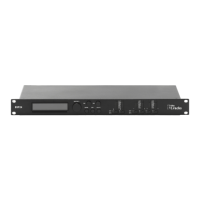ACHAT DSP24 • OWNER’S MANUAL
14
The following is an example screen for the “Delay” page where
the delay time of input channel A is set to 160.1872 ms:
EQ: [x] sub-menu – from this sub-menu it is possible to set ve
available parametric or shelving lters for the input channels.
The DSP24 allows the user to select either bell or shelving
Parameters and assign them independently using the 5
available lters.
In order to select the lter type, it is necessary to have the
lters GAIN=0.0dB. Then using the PM2 encoder, rotate it
“clockwise” in order to set the bell lters bandwidth, or rotate
it “counter-clockwise” to select the shelving lter type (low or
high) and its order (1
st
or 2
nd
).
So, in order to dene the lter type for the lter number 1
(“x”=1), it is necessary from the above screen, to enter the
lters editing page pressing the ENTER button, and the screen
has to appear as follows:
In this case, the lters GAIN=0.0dB, and being BW=1.05, the
current lter selected is a bell type now. Rotating the PM2
encoder clockwise, the parameter BW will range from 0.05 up
to 3 for identifying a bandwidth value for a bell lter.
If a bell lter is selected, then the gain can be modied from
0.0dB and the BW will range between 0.05 and 3.
If the user wants to select a shelving lter from the above
setting, with the GAIN=0.0dB [if the GAIN is not 0.0dB, it is
necessary to set it at 0.0dB using the PM3 encoder], rotate
the PM2 counter-clockwise. Once BW reaches the 0.05 value,
at the next step of the PM2 counter-clockwise rotation, the
selection of the shelving lters will be entered.
Still rotating the PM2 counter-clockwise, the shelving lters
and their order will be selectable in the following sequence:
1. 1
st
order Low Shelving = –6LoSh [on the screen]
2. 2
nd
order Low Shelving = –12LoSh [on the screen]
3. 1
st
order High Shelving = –6HiSh [on the screen]
4. 2
nd
order High Shelving = –12HiSh [on the screen]
Once the desired shelving lter is selected, the PM3 can then
be used to select the desired GAIN and when the GAIN is set
at a value different from 0.0dB, then the lter type cannot be
changed until this GAIN is returned to 0.0dB.
BELL Filter: As an example, if you want to set a bell lter
within EQ-1, then the BW has to be set at a desired value of
say 1.00 using the PM2 encoder, the GAIN at say +3dB using
the PM3 encoder and the centre frequency at say 1.00kHz with
the NAV/PM1 encoder.
The EQ sub-menu screen will show the following:
Once in the bell lters edit screen all the lters parameters can
be modied using the “NAV/PM1”, “PM2” and “PM3” encoders
for editing the lters centre frequency, bandwidth BW and gain.
The centre frequency of the parametric lter can be edited
using the “NAV/PM1” encoder, the BW the “PM2” encoder and
the gain the “PM3” encoder:

